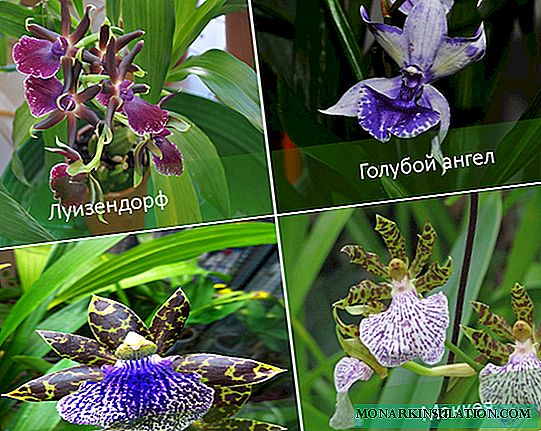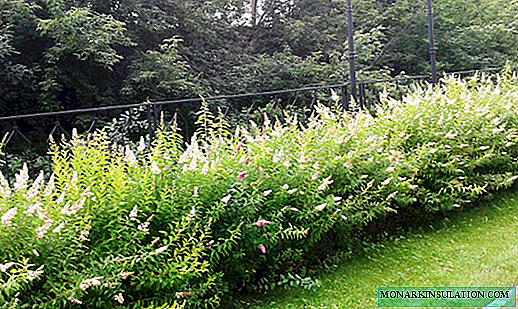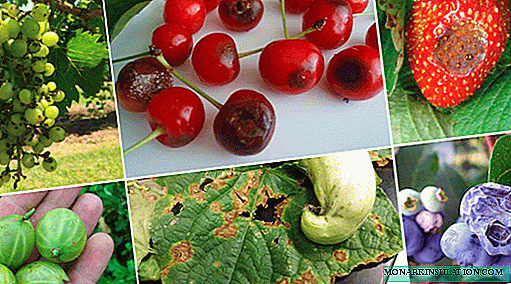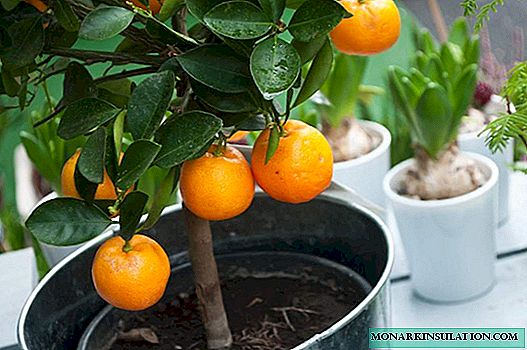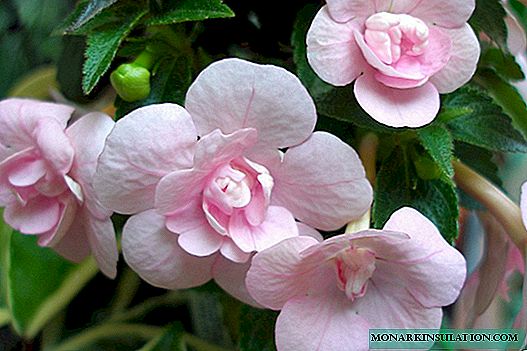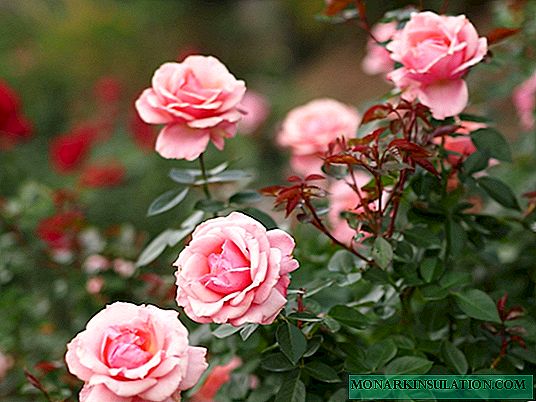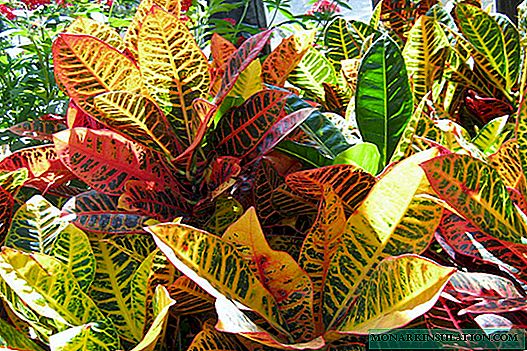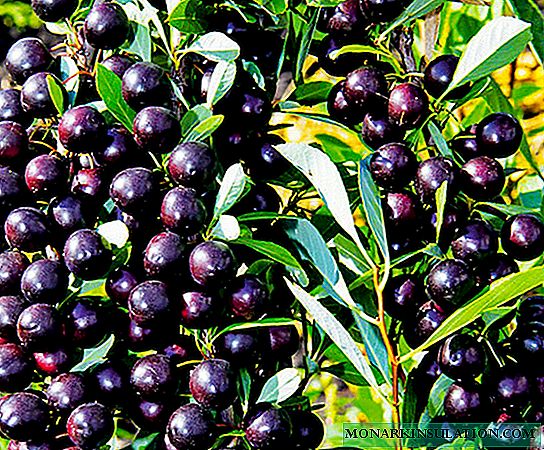
A guest from the American prairies, a lovely Thumbelina, a prima donna of Siberia - it's all about a cherry called Bessey. A little-known, but widespread tree is a micro cherry and has many advantages.
History and Description of Bessey Cherries
Bessey's sandy (steppe) cherry belongs to the genus of microcherry. She came to us from North America, where she grows wild in the prairies, sand dunes, along the banks of the rivers. It was first described in the XIX century by the American scientist Charles Bessie, in whose honor it was named. Since the beginning of the last century, American countries have begun breeding to cultivate Bessei cultivars. A significant number of varieties were obtained, but we have almost unknown ones. At the same time, Bessey came to the USSR, where I.V. Michurin, who recommended this shrub as a protective plantation, was the first to pay attention to her.
From the beginning of the 50s of the last century to the present, cherries have been actively grown in Siberia, the Urals and other regions due to their high frost resistance and unpretentiousness. Siberian breeders have already bred a significant number of Bessei varieties and hybrids. The State Register of the Russian Federation includes 29 varieties of steppe cherries approved for use.

Bessey Cherry is a stunted shrub.
The plant is a shrub up to 1 m high, less often - up to 1.5-2, sometimes 3 m. Brownish branches grow horizontally, often even lie on the ground under the weight of the crop. In more modern varieties, they can grow at an angle of 45 ° and even vertically, which ensures greater productivity. The leaves are oblong, smooth, resembling willow leaves. It blooms late - at the end of May, but for a long time - for 3 weeks. Harvested, usually berries densely cover annual branches. The berries are dark, round (but can also be elongated, oval), small - from 1.5 to 2.5 g. However, on some later varieties, they can reach 3-5 g. The taste is freshly sweet, astringent. The fruits ripen in August, never fall off and can hang on branches for a long time, wilting and acquiring a good taste.

Dark Bessey Cherry Berries
Berries are used for processing, compotes, jams, preserves are cooked from them, and they are also used in dried and dried form.
When planting with cuttings, the cherry begins to bear fruit in the second year, when planting with a seed - in the third. The maximum yield is harvested at 2-5 years of fruiting, usually 3-5 kg from the bush, up to 10 kg in individual varieties and with good care.
An unpretentious and hardy micro cherry will comfortably accommodate and will feel comfortable everywhere, no matter where its fate has thrown. Amazingly resilient, tolerates Siberian frosts and sultry drought equally well. Always pleasing with high decorativeness and fertility. It is delightfully good during the flowering period when the shoots are abundantly strewn with small snow-white flowers, powdered with bright beads of carmine-red stamens. Surprisingly beautiful in the fall, when silver-greenish, elongated-oval, narrow, like willows, the leaves become coral-red.
The advantages of Bessei:
- high frost resistance, withstands frosts down to -50 ° C;
- drought tolerance;
- undemanding to soils, resistance to salinity;
- unpretentiousness in leaving;
- early maturity, begins bearing fruit already in the second year after planting;
- the lack of need for processing from insects, because they are scared away by a specific smell (resembles the smell of bird cherry);
- annual fruiting;
- lack of crumbling berries.
The disadvantages include the susceptibility of cherries in wet weather to coccomycosis and moniliosis.
Video: Bessey Cherry
How to Plant Bessey Cherry
Before planting Bessei on your site, make sure that there is a suitable place for this. It should be elevated, well-lit, ventilated. Cherry is not too picky about soils, but loves sandy, sandy loam more. The earth must be alkaline or neutral, acidic soil must be deoxidized with lime or dolomite flour.
If a place is found, we get seedlings. This is not always an easy question. Not all regions have nurseries that grow Bessei seedlings. Of course, you can find manufacturers and suppliers who will send you seedlings by mail, but you can not always be sure of the quality of such planting material.
Well, if any of the neighbors or acquaintances already grows such a cherry. Then you can just ask them for cuttings or even dig a few branches for rooting. The process is absolutely simple, similar to the reproduction of currants. Having dug up the branches in early spring, by autumn you can get good, rooted seedlings. But it is better to plant them in the spring, autumn plantings carry a risk of freezing, although this cherry is frost-resistant. Therefore, seedlings are best prikupat and cover from frost until spring.

Bessey easily propagated by layering
Step-by-step instruction
The planting of Bessei is simple and not much different from the planting of other cherries:
- In the fall, mark the site. The distance between rows should be 3-3.5 m, between plants in a row - 2 m.
- Prepare landing pits with a diameter of 50-60 cm, a depth of 40-50 cm. The upper fertile soil is folded separately.
- Fill the pits with a mixture of top fertile soil with compost or humus (10-20 kg per pit), add 1 liter of wood ash and a handful of superphosphate. The pits fall asleep completely and from above make a small mound, which will settle until spring.
- In the early spring, before the buds open (this is important), they begin to directly plant. The seedlings are straightened, the damaged ones are pruned with pruning shears. If it was in a container, take it out with a lump of earth and also straighten the roots. If the earth was loose and crumbled - that's okay.
- In the planting pit, a mound is formed, on which a seedling is placed, the roots are distributed around the mound. It is covered with earth, compacted and well watered with water (2-3 buckets).
- Mulch with humus, compost, rotted sawdust, etc.
- The shoot is cut off by 10-15 cm.
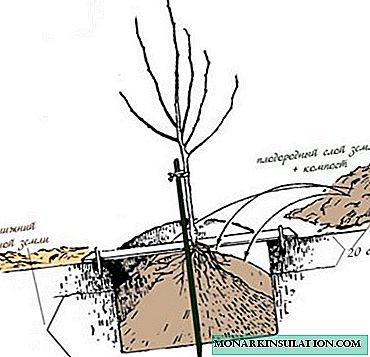
Cherry seedlings are placed on the knoll, spreading the roots along its edges, and then covered with soil
Features of cultivation and subtleties of care
Growing and caring for Bessey is not burdensome and does not require much labor:
- if horizontal branches under the weight of the crop lie on the ground, make backups;
- remove weeds, if any;
- carry out sanitary pruning if necessary;
- fight with fungal diseases when they appear;
- in snowy winters, the bushes are covered with snow, protecting the shoots from drying out in the frosty air.
Pruning
Bessei pruning is infrequent:
- when planting, the seedling is cut by 10-15 cm, after which the bush will form itself due to shoots growing from the root;
- conduct annual sanitary pruning, which boils down to the removal of dried and damaged shoots;
- carry out anti-aging cutting of old shoots in 6-7 years (up to 100% of shoots can be removed, after which new ones will surely grow).

Cherries need sanitary and anti-aging pruning
Graft
Due to its high frost resistance (up to -26 ° C in the soil), Bessey cherries are often used as a stock for their own kind and for many stone fruits (plum, cherry plum, apricot, etc.). In plants grown on such stocks, flowering periods are postponed, which reduces the risk of damage by spring frosts. The growth force also decreases, which simplifies the formation of a low crown. Bessey herself also takes root well, grafted onto the plants of the stone fruit group.
Bessey's cherry is planted on a specially grown stock or on a 1-3-year-old tree (bush). As a stock can be:
- another Bessey;
- plum;
- turn;
- apricot and some others.
The best time for vaccinations is spring, a period of active sap flow. In summer, it is also allowed to carry out the procedure, but the closer to the end, the worse the survival rate.
Bessei can be grafted with both a shank (copulation) and an eye (budding). Vaccinations used:
- in the butt;
- for bark;
- in lateral incision;
- into the cleavage.
Step-by-step instructions for vaccination in the splitting:
- Start with harvesting cuttings. For spring planting, they are prepared in the fall, after leaf fall, even at the beginning of winter. This seemingly simple operation has its own specific rules:
- cuttings need to be cut from proven bushes, as the berries from which you are sure of the yield;
- shoots, from where cuttings are cut, must be annual, well ripened;
- the best cuttings are on the south side of the bush;
- take them from the outside of the crown;
- the length of the handle should be 15-20 cm;
- on the handle should be 4-5 well-developed growth buds;
- the shorter the internodes, the better;
- the number of cuttings to be cut should be slightly larger than required.
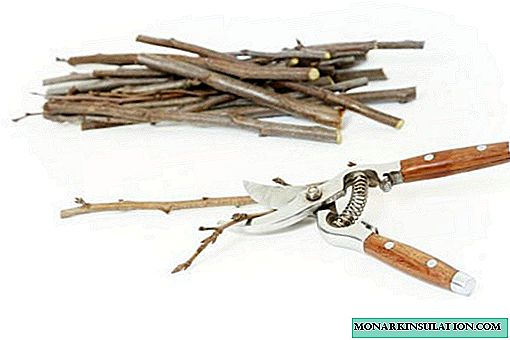
Bessei cuttings are harvested 15-20 cm long, with 4-5 well developed buds
- Store chopped cuttings in this way:
- treat slices with garden varieties;
- bind the cuttings in bundles, put in a plastic bag, but do not tie - they must breathe air;
- placed in a container, covered with wet sand or sawdust;
- the container is stored in a basement or refrigerator at a temperature of about 0 ° C;
- they take the cuttings from the store immediately before the vaccination operation, because at this moment they should be sleeping.
- Then prepare the stock:
- The selected branch is cut at a right angle to its axis with a sharp garden hacksaw or knife.
- A hatchet or knife make an incision in the middle of the branch with a depth of 10 cm. The diameter of the stock should be twice the diameter of the scion. If the diameter of the stock is even larger, you can plant two (or even 3 and 4) cuttings on it.

In the middle of the scion, a 10 cm deep incision is made.
- A screwdriver or sliver is inserted into the cleavage so that it does not close.
- Prepare a scion:
- They take out the stalk, make sure that it is preserved and viable:
- the bark looks fresh and smooth;
- the stalk is easily bent;
- scales are smooth, elastic;
- the wood on the cut is fresh, light green in color.
- A sharp knife from one end of the handle makes 2 slices forming a wedge, 10-15 mm long.
- They take out the stalk, make sure that it is preserved and viable:
- Inoculate:
- The prepared shank (or 2) is inserted into the cleavage so that the plane of the slices (the so-called cambial layers) fit well against each other.

Prepared cuttings are inserted into the rootstock split so that the plane of the cuts fit snugly together
- Carefully take out a screwdriver, the handle (cuttings) remains in the splinter.
- The vaccination site is wrapped tightly with tape.

After vaccination, it is wrapped with tape
- The upper cut of the rootstock and the vaccination site are well coated with garden var.
- Put on a package grafted with grafts to create the desired moisture.
- After 2 weeks, the vaccine usually takes root, the package is removed. Adhesive tape is removed after the stock and scion are completely fused.
- The prepared shank (or 2) is inserted into the cleavage so that the plane of the slices (the so-called cambial layers) fit well against each other.
Bessei grafting on an ordinary cherry
Bessey, strictly speaking, is not really cherry. By origin, it is much closer to the sink and, as a result, does not interbreed with ordinary cherries. Thus, Bessei's vaccinations for cherries do not take root, and vice versa - an ordinary cherry does not take root, grafted onto Bessei.
How to Grow Bessey Cherry Seeds
Bessei reproduces very well by seed. For this, seeds from ripe berries are used. The sequence of growing seedlings from seed:
- The selected bones are washed and placed for 7 days in water.
- Planting material is washed again and placed in a container filled with sphagnum moss, previously saturated with water, for several weeks at a temperature of + 18 ... + 20 ° C. The bones should swell during this time.
- For seed germination, the container is placed in a refrigerator with a temperature of + 3 ... + 6 ° C until half of the seeds are pecked. Then the hatching seeds are placed on a shelf of the refrigerator with a temperature of 0 ° C to suspend growth, where they are stored until sowing.
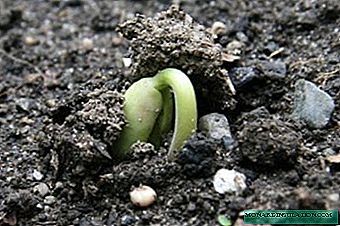
Sprouts hatch at a temperature of + 3 ... + 6 ° C
- 3-4 days before sowing, the seeds are heated at a temperature of + 19 ... + 21 ° C.
- Sprouted seeds can be sown immediately in the ground in a permanent place, but it is better to do this in a container with a depth of at least 30 cm. Pre-disinfect it, then lay drainage on the bottom, for example, of expanded clay, and fill it with prepared soil (garden soil is mixed in equal proportions, humus or compost and peat), after which seeds are planted.
- A year later, the young seedling is ready for planting in a permanent place.
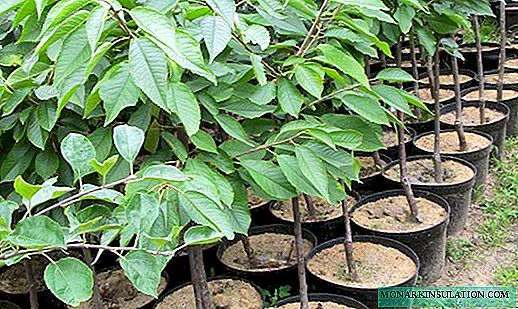
A year after sowing the seeds of cherry in the pots, the seedlings will be ready for planting
Diseases and pests, methods of dealing with them
As already mentioned, Bessei has no pests. Fortunately, they fly around her side. Some varieties in some years with high humidity can be affected by fungal diseases - coccomycosis and moniliosis. Rarely (in cold and rainy summers) a defeat of kleasterosporiosis is possible.
Coccomycosis
Coccomycosis manifests itself as follows:
- Brownish or reddish spots appear on the outside of the leaves.
- Over time, they increase, the flesh of the leaves dries out, purple spots appear on the inside of the leaves.
- By the end of July, the affected leaves completely dry and fall off. The bush may lose foliage (the so-called summer leaf fall).
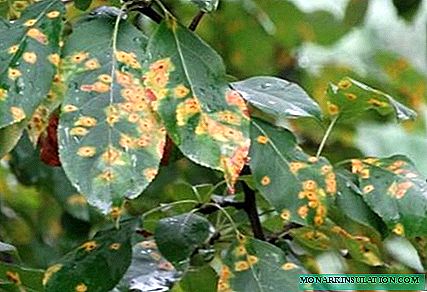
With coccomycosis, spots appear on the leaves
All fallen leaves are collected and burned. Bushes are treated with systemic fungicides (drugs to combat fungal diseases). Well established Chorus and Quadris. Processing is carried out with an interval of 2 weeks, alternating drugs. Since the funds are addictive, it is advisable to use them no more than 3 times a season each. Berries can be eaten 3-5 days after treatment with Quadris and 7 days after treatment with Horus. In autumn and (or) early spring, it is advisable to treat the plant with a 3% solution of iron sulfate or Bordeaux mixture for prevention.
Moniliosis
Moniliosis, or monilial burn manifests itself in the spring, during flowering. Through the bud, the spores of the fungus enter the wood. Affected branches, leaves, flowers look like burned, but many gardeners believe that these are signs of winter frostbite or excessive spring treatment with chemicals.

Monnilliosis defeat looks like a burn
The affected shoots must be cut and burned, the remaining ones should be treated with systemic fungicides, as with coccomycosis. In autumn and spring, the plant must be treated with a 3% solution of iron sulfate or Bordeaux mixture.
Kleasterosporiosis
Kleasterosporiosis, or holey spotting affects leaves, shoots, flowers. The disease begins with the appearance of red-brown spots on the leaves. Spots, as they increase, dry out inside and form holes. Leaves and berries dry and fall. The spores of the fungus winter in the bark, on the leaves, in the soil. Control measures are similar to the previous ones.

With kleasterosporiosis holes form on the leaves of cherry
Bessey Reviews
The year before last, I bought cherry Bessey by mail. While the parcel was on, November came; there was even snow already. On the advice of the letter attached to the parcel, I dug the seedlings almost in a horizontal position. It so happened that last year for some reason I couldn’t get to the cottage and there was nobody to entrust. Arriving this year, I found that all the seedlings are alive, blooming and nothing bad happened to them, only Bessey's cherry released many new branches that are not parallel to the stem, but strictly perpendicular.
Helena
//forum.tvoysad.ru/viewtopic.php?t=6247&start=540
Riga, sandy, besessey - varieties of the same species. For pollination of the second copy. needed. Moniliosis can be affected. Varieties bred in Siberia, we burn from it quickly. Taste. It reminds many of bird cherry. For me it’s better. Unpretentious. The root system withstands record minus temperatures. They write that in the winter the root neck can support. This has not happened to me. With plum and cherry felt is pollinated, but not for harvest.With good pollination, the crop is plentiful. But more suitable for processing. The berries are usually black. There are varieties with green and yellow berries.
Blooms profusely, almost never falling under late frosts due to late flowering. In late May, early June. In summer, the leaves are silvery. In the fall they are painted in very bright yellow-red colors.Sorokin
//www.websad.ru/archdis.php?code=706346&subrub=%CF%EB%EE%E4%EE%E2%FB%E5+%E4%E5%F0%E5%E2%FC%FF
Bessey is a sand cherry. It does not freeze 100% with us - it sits on my retaining wall, the roots are close to the freezing stones. But apparently getting wet - transplanted three bushes at the foot of a small slope, she really did not like ((
The berries are large, dark-dark-cherry, on the palate - something between cherries and cherries)) Sweet, but without sugaryness, a little tart. For me, the only cherry I can eat.
The bush has a specific form - slightly creeping, but easily formed. The color of the leaves is pleasant gray-greenish, blooms profusely with fragrant small white flowers.Contessa
//www.e1.ru/talk/forum/read.php?f=122&i=261730&t=261730
Bessey relatively recently moved to us from the American continent. She has more advantages than disadvantages. Of course, it does not compete with many common varieties of cherries, but it is an excellent addition to them and deserves its place in the garden and on farms. If you can allocate a place, as well as purchase several seedlings, you should definitely try to grow this wonderful cherry and see for yourself the correctness of the information provided.










